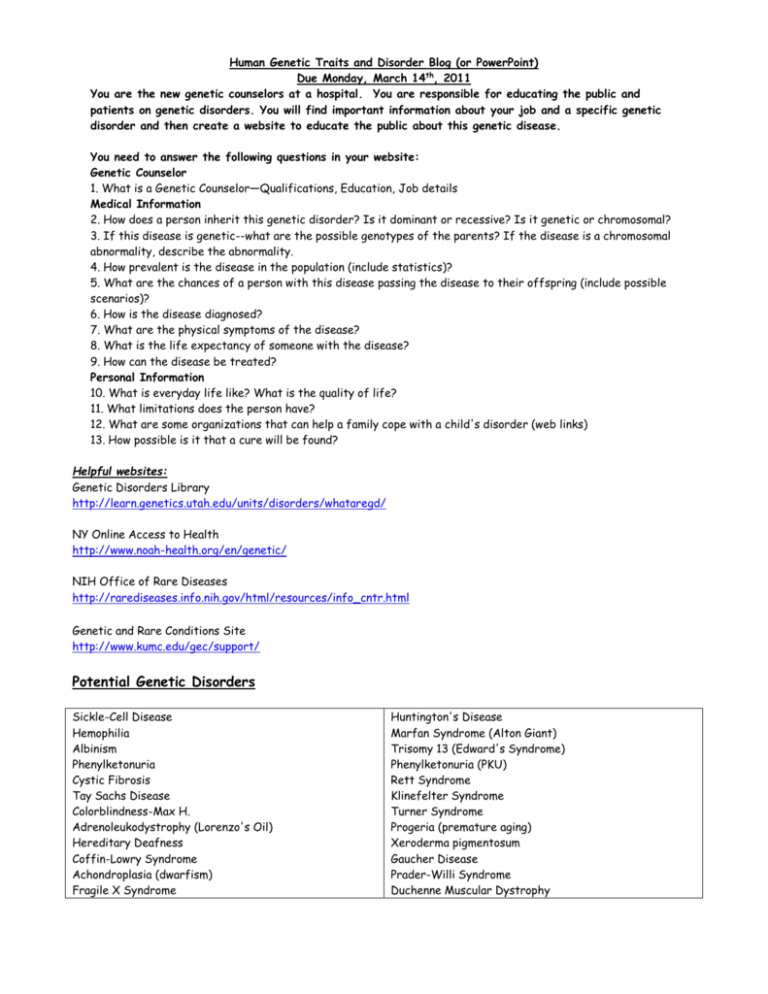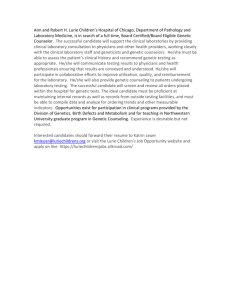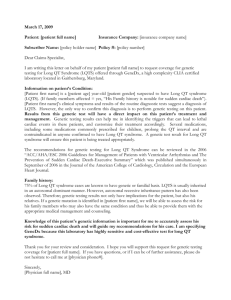Human Genetic Traits and Disorders
advertisement

Human Genetic Traits and Disorder Blog (or PowerPoint) Due Monday, March 14th, 2011 You are the new genetic counselors at a hospital. You are responsible for educating the public and patients on genetic disorders. You will find important information about your job and a specific genetic disorder and then create a website to educate the public about this genetic disease. You need to answer the following questions in your website: Genetic Counselor 1. What is a Genetic Counselor—Qualifications, Education, Job details Medical Information 2. How does a person inherit this genetic disorder? Is it dominant or recessive? Is it genetic or chromosomal? 3. If this disease is genetic--what are the possible genotypes of the parents? If the disease is a chromosomal abnormality, describe the abnormality. 4. How prevalent is the disease in the population (include statistics)? 5. What are the chances of a person with this disease passing the disease to their offspring (include possible scenarios)? 6. How is the disease diagnosed? 7. What are the physical symptoms of the disease? 8. What is the life expectancy of someone with the disease? 9. How can the disease be treated? Personal Information 10. What is everyday life like? What is the quality of life? 11. What limitations does the person have? 12. What are some organizations that can help a family cope with a child's disorder (web links) 13. How possible is it that a cure will be found? Helpful websites: Genetic Disorders Library http://learn.genetics.utah.edu/units/disorders/whataregd/ NY Online Access to Health http://www.noah-health.org/en/genetic/ NIH Office of Rare Diseases http://rarediseases.info.nih.gov/html/resources/info_cntr.html Genetic and Rare Conditions Site http://www.kumc.edu/gec/support/ Potential Genetic Disorders Sickle-Cell Disease Hemophilia Albinism Phenylketonuria Cystic Fibrosis Tay Sachs Disease Colorblindness-Max H. Adrenoleukodystrophy (Lorenzo's Oil) Hereditary Deafness Coffin-Lowry Syndrome Achondroplasia (dwarfism) Fragile X Syndrome Huntington's Disease Marfan Syndrome (Alton Giant) Trisomy 13 (Edward's Syndrome) Phenylketonuria (PKU) Rett Syndrome Klinefelter Syndrome Turner Syndrome Progeria (premature aging) Xeroderma pigmentosum Gaucher Disease Prader-Willi Syndrome Duchenne Muscular Dystrophy **Remember all information and pictures must be cited. Any direct quotes must have a citation after it, otherwise a list of citations can be used for the entire project (this means to paraphrase as much as possible!!!) All pictures must include a citation next to it. CATEGORY Content Accuracy (x15) _______/60 pts Layout (x5) _______/20 pts Copyright (x5) _______/20 pts Spelling and Grammar (x5) _______/20 pts Interest (x10) ______/40 pts 4 3 2 1 All information provided by the student on the Web site is accurate and all the requirements of the assignment have been met. Almost all the information provided by the student on the Web site is accurate and all requirements of the assignment have been met. Almost all of the information provided by the student on the Web site is accurate and almost all of the requirements have been met. There are several inaccuracies in the content provided by the students OR many of the requirements were not met. The Web site has an exceptionally attractive and usable layout. It is easy to locate all important elements. White space, graphic elements and/or alignment are used effectively to organize material. The Web pages have an attractive and usable layout. It is easy to locate all important elements. The Web pages have a usable layout, but may appear busy or boring. It is easy to locate most of the important elements. The Web pages are cluttered looking or confusing. It is often difficult to locate important elements. Fair use guidelines are followed with clear, easy-to-locate and accurate citations for all borrowed material. No material is included from Web sites that state that permission is required unless permission has been obtained. Fair use guidelines are followed with clear, easy-to-locate and accurate citations for almost all borrowed material. No material is included from Web sites that state that permission is required unless permission has been obtained. Fair use guidelines are followed with clear, easy-to-locate and accurate citations for most borrowed material. No material is included from Web sites that state that permission is required unless permission has been obtained. Borrowed materials are not properly documented OR material was borrowed without permission from a site that requires permission There are no errors in spelling, punctuation or grammar in the final draft of the Web site. There are 1-3 errors in spelling, punctuation or grammar in the final draft of the Web site. There are 4-5 errors in spelling, punctuation or grammar in the final draft of the Web site. There are more than 5 errors in spelling, punctuation or grammar in the final draft of the Web site. The author has made an exceptional attempt to make the content of this Web site interesting to the people for whom it is intended. The author has tried to make the content of this Web site interesting to the people for whom it is intended. The author has put lots of information in the Web site but there is little evidence that the person tried to present the information in an interesting way. The author has provided only the minimum amount of information and has not transformed the information to make it more interesting to the audience (e.g., has only provided a list of links to the content of others). Total: __________/160 points










